I think I understand the problem now (answer only applies if I really did...):
You sample values at a nominal speed sn. But actually your sampler samples at a real speed s, where s != sn. Now, you want to create a function which re-samples the series, sampled at speed s, so it yields a series as if it were sampled with speed sn by means of linear interpolation between 2 adjacent samples. Or, your sampler jitters (has variances in time when it actually samples, which is sn + Noise(sn)).
Here is my approach - a function named "re-sample". It takes the sample data and a list of desired re-sample-points.
For any re-sample point which would index outside the raw data, it returns the respective border value.
let resample (data : float array) times =
let N = Array.length data
let maxIndex = N-1
let weight (t : float) =
t - (floor t)
let interpolate x1 x2 w = x1 * (1.0 - w) + x2 * w
let interp t1 t2 w =
//printfn "t1 = %d t2 = %d w = %f" t1 t2 w
interpolate (data.[t1]) (data.[t2]) w
let inter t =
let t1 = int (floor t)
match t1 with
| x when x >= 0 && x < maxIndex ->
let t2 = t1 + 1
interp t1 t2 (weight t)
| x when x >= maxIndex -> data.[maxIndex]
| _ -> data.[0]
times
|> List.map (fun t -> t, inter t)
|> Array.ofList
let raw_data = [8; 12; 16; 20] |> List.map float |> Array.ofList
let resampled = resample raw_data [0.0..0.2..4.0]
And yields:
val resample : data:float array -> times:float list -> (float * float) []
val raw_data : float [] = [|8.0; 12.0; 16.0; 20.0|]
val resampled : (float * float) [] =
[|(0.0, 8.0); (0.2, 8.8); (0.4, 9.6); (0.6, 10.4); (0.8, 11.2); (1.0, 12.0);
(1.2, 12.8); (1.4, 13.6); (1.6, 14.4); (1.8, 15.2); (2.0, 16.0);
(2.2, 16.8); (2.4, 17.6); (2.6, 18.4); (2.8, 19.2); (3.0, 20.0);
(3.2, 20.0); (3.4, 20.0); (3.6, 20.0); (3.8, 20.0); (4.0, 20.0)|]
Now, I still fail to understand the "wrap around" part of your question. In the end, interpolation - in contrast to extrapolation is only defined for values in [0..N-1]. So it is up to you to decide if the function should produce a run time error or simply use the edge values (or 0) for time values out of bounds of your raw data array.
EDIT
As it turned out, it is about how to use a cyclic (ring) buffer for this as well.
Here, a version of the resample function, using a cyclic buffer. Along with some operations.
update adds a new sample value to the ring bufferread reads the content a ring buffer element as if it were a normal array, indexed from [0..N-1].initXXX functions which create the ring buffer in various forms.length which returns the length or capacity of the ring buffer.
The ring buffer logics is factored into a module to keep it all clean.
module Cyclic =
let wrap n x = x % n // % is modulo operator, just like in C/C++
type Series = { A : float array; WritePosition : int }
let init (n : int) =
{ A = Array.init n (fun i -> 0.);
WritePosition = 0
}
let initFromArray a =
let n = Array.length a
{ A = Array.copy a;
WritePosition = 0
}
let initUseArray a =
let n = Array.length a
{ A = a;
WritePosition = 0
}
let update (sample : float ) (series : Series) =
let wrapper = wrap (Array.length series.A)
series.A.[series.WritePosition] <- sample
{ series with
WritePosition = wrapper (series.WritePosition + 1) }
let read i series =
let n = Array.length series.A
let wrapper = wrap (Array.length series.A)
series.A.[wrapper (series.WritePosition + i)]
let length (series : Series) = Array.length (series.A)
let resampleSeries (data : Cyclic.Series) times =
let N = Cyclic.length data
let maxIndex = N-1
let weight (t : float) =
t - (floor t)
let interpolate x1 x2 w = x1 * (1.0 - w) + x2 * w
let interp t1 t2 w =
interpolate (Cyclic.read t1 data) (Cyclic.read t2 data) w
let inter t =
let t1 = int (floor t)
match t1 with
| x when x >= 0 && x < maxIndex ->
let t2 = t1 + 1
interp t1 t2 (weight t)
| x when x >= maxIndex -> Cyclic.read maxIndex data
| _ -> Cyclic.read 0 data
times
|> List.map (fun t -> t, inter t)
|> Array.ofList
let input = raw_data
let rawSeries0 = Cyclic.initFromArray input
(resampleSeries rawSeries0 [0.0..0.2..4.0]) = resampled
